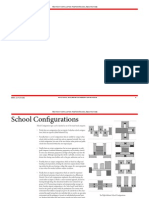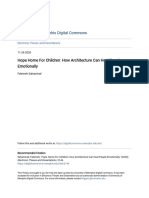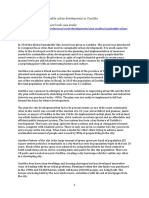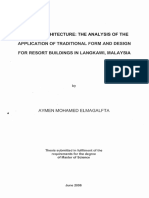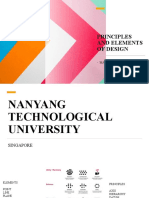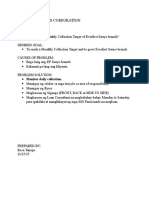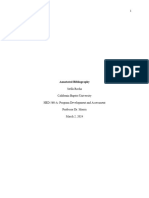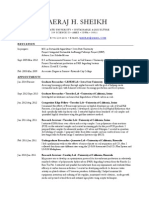5.0 Site Concept1
5.0 Site Concept1
Uploaded by
ianyanCopyright:
Available Formats
5.0 Site Concept1
5.0 Site Concept1
Uploaded by
ianyanOriginal Description:
Copyright
Available Formats
Share this document
Did you find this document useful?
Is this content inappropriate?
Copyright:
Available Formats
5.0 Site Concept1
5.0 Site Concept1
Uploaded by
ianyanCopyright:
Available Formats
DESIGN CONCEPTS
5.0 DESIGN CONCEPTS
5.1
Site Concepts
In response to the goals of the BCOE and the LRDP, the following concepts have been
introduced in the site planning for EBU2. Refer to the site plan on the following page for
illustration of these concepts.
1. Courtyards and Plazas:
Develop and extend the existing BCOE courtyard as a semiprivate space for college use
while developing the larger mall and plazas on the south. Continue to enhance and
develop the courtyard respecting the scale, orientation and functions that exists.
Encourage pedestrian circulation on the south side of Bourns Hall toward the secondary
entry for the general assignment instructional spaces. This creates an opportunity for
campus plazas to connect main circulation pathways.
Site Concepts Plan
UNIVERSITY OF CALIFORNIA RIVERSIDE
ENGINEERING BUILDING UNIT 2
DETAILED PROJECT PROGRAM PROJECT NO. 950439 SRG Partnership, Inc
5-1
DESIGN CONCEPTS
2. Entries:
Provide an entrance into EBU2 as a terminus to the BCOE courtyard and hearth of the
college. Allow for a hierarchical sequence of spatial experiences from the largest public to the smaller, semiprivate within the building perimeter.
3. Siting the Building:
Site the new building to respond to natural forces of sun orientation and prevailing
winds. Offices should be located on the north with research on the south. Use support
space as a central organizing element.
Define the north edge of the site by aligning EBU2 with Bourns Hall and step back as
Campus Drive curves. Respect the massing and proportions of Bourns Hall with EBU2
and create a gateway into the Engineering Precinct from Campus Drive. Define the
eastern edge of the Engineering Precinct at the pedestrian path to the campus from the
residence halls.
4. Connections to Bourns Hall:
Provide a direct connection to Bourns Hall at the ground level through open courtyards
and walkways. Provide a bridge connection to Bourns Hall on the second and third
levels at the south wing.
5. Service:
Separate service from the main entries and provide screening of the service area. Maintain
emergency vehicle access to the east and south portions of the site.
5.2
Site and Building Design
The design concept should integrate the building into the overall campus fabric, character and design. The new building should reflect the commitment that the University of
California, Riverside has to a new generation of campus expansion with an emphasis
on quality design, materials and landscape. EBU2 will provide a greater density of
building facility than previous building projects while remaining sensitive to the inherent
scale and character of the existing campus.
Site Design Plan
UNIVERSITY OF CALIFORNIA RIVERSIDE
ENGINEERING BUILDING UNIT 2
DETAILED PROJECT PROGRAM PROJECT NO. 950439 SRG Partnership, Inc
5-2
DESIGN CONCEPTS
Landscape
Site
The project can be seen as a terminus to the existing Bourns Hall courtyard. Its proposed uses do not encourage pedestrian traffic through the building in route to other
portions of the campus. Continuation of the Arroyo on the north will provide a soft,
natural edge to the project, and the preservation of the eucalyptus grove on the south
slope by the fire lane will give the appearance of longevity to the project. Consideration
should be given to adding some Tristania conferta (Brisbane Box) trees to the slope
presently planted with Eucalyptus trees.
Bourns College of Engineering courtyard view to East
Trees
The eucalyptus trees in the existing parking lot will have to be removed to accommodate
the new building. In consideration of their age and stature on the campus this will not
negatively impact the campus ecology. The sidewalk along North Campus Drive should
be replaced with integrally colored concrete in UCR tan. The street trees should be
appraised for replacement or preservation. Replacement street trees should be Fraxinus
velutina modesto (Modesto ash) in accordance with the Campus Landscape Master
Plan.
Eucalyptus tree protection should include fencing or otherwise sequestering trees from
construction activities. Water must be provided to maintain the trees in a healthy condition, and no construction materials should be stored at the base of the trees. Excavation within the drip line of the trees must be strongly discouraged except where absolutely necessary, and any trenching within the drip line must be by hand excavation only.
Relocation of existing trees is not recommended.
UNIVERSITY OF CALIFORNIA RIVERSIDE
ENGINEERING BUILDING UNIT 2
DETAILED PROJECT PROGRAM PROJECT NO. 950439 SRG Partnership, Inc
5-3
DESIGN CONCEPTS
P aving
Coordination of the paving patterns used at Bourns Hall will unify the buildings within
the Engineering Precinct. Enhancement of the paving southeast of the site, at the intersection of the fire lanes leading to Geology, Pierce Hall and Bourns Hall, will encourage
pedestrians to traverse to the west. Northeast passage at this point will connect travelers
to the Residence Halls. Important gathering nodes have been identified at this southeast
area as well as at the south entry/exit to Bourns Hall, continuing south to the Carillon
Mall. The south path intersection with the Bookstore Mall is another gathering node,
dispersing pedestrians south to Carillon Mall and north to North Campus Drive. Special
paving and landscape treatments can emphasize the gathering nodes, directing pedestrians to the desired routes.
BCOE courtyard at bridge
Shrubs
Shrubs throughout the site should be drought tolerant, easily maintained and colorful.
Whether planted near buildings or in open spaces, ultimate shrub heights should respond to window heights and security issues. The UCR campus palette as described in
the Campus Landscape Master Plan should be utilized.
Lighting
Site lighting consisting of pole lights, bollards, step lights and landscape lights will guide
visitors through the site at night. Special fixtures at the south portion of the site will direct
pedestrians to the preferred route south of the building.
BCOE terrace in courtyard view west
Furnishings
Site furnishings are an important feature in the context of this facility. Some of the issues
that need to be addressed in selection of these furnishings include: Recalling furnishings
used elsewhere on campus, comfort, ADA accessibility, ease of maintenance and durability.
Irrigation
Irrigation should be tied into existing points of connection and a new automatic controller should be provided as a part of the project. If necessary, it may be possible to utilize
the existing controller at the southeast corner of the Physics Annex. Moisture sensors
should be included as a part of the required irrigation equipment, so that an accurate
soil profile indicating soil moisture and oxygen can be obtained. Irrigation methods
should be studied to determine the most effective method for providing complete ground
plane coverage as well as an enduring deep water application for the trees.
BCOE courtyard view west
UNIVERSITY OF CALIFORNIA RIVERSIDE
ENGINEERING BUILDING UNIT 2
DETAILED PROJECT PROGRAM PROJECT NO. 950439 SRG Partnership, Inc
5-4
DESIGN CONCEPTS
5.3
Building Design Issues
Design PPrinciples
rinciples
The Computer Science and Engineering & Electrical Engineering departments place an
emphasis on human need and issues. Their work involves ideas, not machines and
emphasizes people over technology. Their commitment is in making better places to live
and work. The following six principles add qualitative dimensions to the program and
focus on encouraging human interaction and collegiality.
1. Create a hierarchy and diversity of interactive spaces from public to private. Enhance the different functions and needs through a careful use of scale, placement
and design character. Lobbies and teaching labs define the major public space,
research areas will define the semipublic space, and faculty offices will define the
private space.
2. Provide adjacency of departmental offices in a central location to encourage interaction between the Computer Science and Engineering department and the Electrical
Engineering department through a separate administration space on one floor.
3. Provide attractions at all building levels through the use of unique interactive space
and program uses. Each floor should have program space which attracts faculty
and encourages their interaction.
4. Integrate activities and connections between the first and second floors for flow of
traffic. Facilitate the connection between Bourns Hall and EBU2. Provide clear and
open connections between the first and second floors for undergraduate public uses.
5. Encourage interaction between faculty through the use of office clusters. Organize
the clusters around break out spaces for convenience of meetings and discussions.
Provide clear orientation and visual connection to the outdoors. Allow for north
facing orientation of the offices to minimize solar gain and benefit from the views to
the Arroyo and Box Springs Mountains.
6. Develop research clusters in pods of three to four for optimum critical mass and
interaction. Clusters of three to four allow for maximum flexibility and expandability
while maintaining the necessary ratio of offices to labs.
UNIVERSITY OF CALIFORNIA RIVERSIDE
ENGINEERING BUILDING UNIT 2
DETAILED PROJECT PROGRAM PROJECT NO. 950439 SRG Partnership, Inc
5-5
DESIGN CONCEPTS
5.4
Plan Or
ganization
Organization
The building axis aligns with the existing BCOE courtyard and forms the central organizational focus to the Engineering Precinct. This focus forms the hearth of the college.
The ground and second levels are identified as undergraduate public space for Teaching and Learning. Both teaching labs and general assignment instructional spaces will
be located on these levels. This relationship is a continuation of the existing uses in
Bourns Hall.
The upper three levels are designated for the Research and Discovery uses. Research
and Discovery is for faculty and graduate student research and office space. The core
of EBU2 serves as an organizational lobby with core functions for elevators, stairs, toilets
and lab support spaces. These adjacency diagrams, shown in more detail in Section
3.0, illustrate the relationships in each of these categories.
5.5
Research and Discovery
Research and Discovery layout concepts have been studied in a variety of configurations. Providing a range of space for casual interaction between faculty is critical.
Locating research labs on the upper floors allows for increased security and privacy. Each floor should provide a ratio of two faculty offices to one research lab and maximize the lab arrangement for future
expansion and flexibility. Three to four lab modules form a critical
mass.
The following page illustrates a number of opportunities that exist for
these arrangements and their impact on the site.
UNIVERSITY OF CALIFORNIA RIVERSIDE
ENGINEERING BUILDING UNIT 2
DETAILED PROJECT PROGRAM PROJECT NO. 950439 SRG Partnership, Inc
5-6
DESIGN CONCEPTS
Concepts/Options
K
UNIVERSITY OF CALIFORNIA RIVERSIDE
ENGINEERING BUILDING UNIT 2
DETAILED PROJECT PROGRAM PROJECT NO. 950439 SRG Partnership, Inc
5-7
DESIGN CONCEPTS
Lab/Office Clusters
The conceptual floor plan for EBU2 is organized as a
arrangement of clusters of research labs and faculty
offices. The clusters meet the need for flexibility, organization, scale and privacy. Office spaces should
be located on the north face of the building, allowing for minimized solar gain and taking advantage
of the views to the Arroyo and Box Springs Mountains. These diagrams illustrate the opportunities for
cluster arrangements reviewed by the DPP committee.
UNIVERSITY OF CALIFORNIA RIVERSIDE
ENGINEERING BUILDING UNIT 2
DETAILED PROJECT PROGRAM PROJECT NO. 950439 SRG Partnership, Inc
5-8
DESIGN CONCEPTS
Lab Clusters on Site
These illustrations test the feasibility for placing various lab cluster arrangements on the site.
Although the site poses several restrictions, it is able to accommodate several design solutions for lab cluster arrangements. These clusters were reviewed and discussed by the DPP
committee with several conclusions. It was agreed that the faculty preferred to be clustered
together for convenient interaction. The offices prefer north orientation to take advantage of
the views and north daylight. The research labs need to be clustered in groups of three to
four for convenience and flexibility. It is very important to provide interaction spaces throughout the plan as is illustrated by the purple nodes in these diagrams.
UNIVERSITY OF CALIFORNIA RIVERSIDE
ENGINEERING BUILDING UNIT 2
DETAILED PROJECT PROGRAM PROJECT NO. 950439 SRG Partnership, Inc
5-9
DESIGN CONCEPTS
5.6
Teaching and LLearning
earning
The Teaching and Learning category in the plan organization
includes general assignment instructional space and teaching
labs. The teaching labs should be located on the first and second floors that align with the existing Bourns Hall. These spaces
have a greater degree of undergraduate use and need less privacy and security. The alignment with the existing Bourns Hall is
a natural extension of the existing teaching labs.
5.7
College Integration and Expansion
These diagrams reflect the existing Bourns Hall, the proposed
Engineering Building Unit 2 and future development of BCOE
within the LRDP Engineering Precinct.
ure
Fut ansion
Exp
rns
Bou
ting
Exis l
l
Ha
ed
pos
Pro 2
EBU
ure
Fut ansion
Exp
The Second Floor has a direct relationship to Bourns Hall research and office spaces. This floor has a bridge connecting
the existing Bourns Hall north and south wings. Teaching labs
and seminar rooms will be located on this floor.
EBU2 will also have a bridge connection to Bourns Hall on the
third floor. This floor will have the department chair offices in
addition to research labs and faculty offices.
The First Floor serves as the main entrance for both EBU2 and
general assignment instruction spaces. Each of these entries
are to be distinct and separate. Existing relationships to the
BCOE courtyard and general classroom space are illustrated.
rns
Bou
g
n
i
t
Exis l
l
a
H
ed
osa
p
o
Pr 2
EBU
UNIVERSITY OF CALIFORNIA RIVERSIDE
ENGINEERING BUILDING UNIT 2
DETAILED PROJECT PROGRAM PROJECT NO. 950439 SRG Partnership, Inc
5-10
DESIGN CONCEPTS
5.8
Concept Building Design
UNIVERSITY OF CALIFORNIA RIVERSIDE
ENGINEERING BUILDING UNIT 2
DETAILED PROJECT PROGRAM PROJECT NO. 950439 SRG Partnership, Inc
5-11
DESIGN CONCEPTS
Concept Floor Plans
UNIVERSITY OF CALIFORNIA RIVERSIDE
ENGINEERING BUILDING UNIT 2
DETAILED PROJECT PROGRAM PROJECT NO. 950439 SRG Partnership, Inc
5-12
DESIGN CONCEPTS
UNIVERSITY OF CALIFORNIA RIVERSIDE
ENGINEERING BUILDING UNIT 2
DETAILED PROJECT PROGRAM PROJECT NO. 950439 SRG Partnership, Inc
5-13
DESIGN CONCEPTS
Building PPrrogram by Floor
FLOOR LEVEL
QTY
First Floor
Resource Area/Reading Room
1
Student Study
1
Clubs and Honors
1
Teaching Labs
5
Teaching Lab Support
1
General Assignment Instructional Space 5
Service/ Mechanical
Subtotal FFirst
irst Floor asf
16,486
Second Floor
Conference Room/Seminar
1
Conference Room Support (Break-Out) 1
Design Rooms
2
TA Offices
81
Teaching Labs
9
Teaching Lab Support
1
Subtotal Second Floor asf
2,400
600
800
3,240
10,800
1,200
19,040
Third Floor
Research Labs
Research Support Space
Faculty Offices
Chairs Offices (EE & C.S.)
Post Doc. Scholars
Administrative Staff (EE & C.S.)
MSO Mgmt Serv. Officer
Copy/Supply
Workroom
Department Storage
Conference
Faculty Lounge
Graduate Lounge
Subtotal Third Floor asf
9
3
15
2
9
9
2
1
1
2
1
1
1
10,800
420
2,100
560
540
1,080
280
140
140
280
280
500
400
17,520
10
2
20
7
1/2
1/2
1
1
12,000
280
2,800
420
70
70
280
2,400
18,320
Fourth Floor
Research Labs
Research Support Space
Faculty Offices
Post Doc. Scholars
Copy/Supply
Workroom
Conference
Centers/CRIS
Subtotal FFourth
ourth Floor asf
Fifth Floor
Research Labs
Research Support Space
Faculty Offices
Post Doc. Scholars
Copy/Supply
Workroom
Conference
Centers/CCSE & CCN
Subtotal FFifth
ifth Floor asf
Total Assignable Area:
T O TAL
1,200
1,200
1,530
6,000
1,200
5,356
10
2
20
7
1/2
1/2
1
2
12,000
280
2,800
420
70
70
280
2,400
18,320
89,686 asg
Gross @ 59%
152,010 sf
UNIVERSITY OF CALIFORNIA RIVERSIDE
ENGINEERING BUILDING UNIT 2
DETAILED PROJECT PROGRAM PROJECT NO. 950439 SRG Partnership, Inc
5-14
DESIGN CONCEPTS
Vertical Section Or
ganization
Organization
The conceptual vertical organization of EBU2 consists of a five story building with the
first floor set on grade level equal with the existing Bourns Hall. The second and third
floor levels should align with Bourns Hall.
Locating the general assignment instructional space and teaching labs on the ground
floor, as well as providing an active function on the ground floor enhances access and
exiting.
Existing Bourns Hall
5.9
Proposed Addition
Massing
The relationship of EBU2 to Bourns Hall suggests that the massing of the building provide a strong edge along North Campus Drive that defines the entrance to the Engineering Precinct. The building should step back as North Campus Drive curves along the
north edge of the site. The building should also step vertically at the top floor either
through manipulation of the plan, or by changing the exterior material selection and/or
pattern. This addresses human scale issues without violating the concept of a strong
building edge.
The massing should be further articulated by stepping the mechanical penthouse back
from the south edge of the building. Material selection might be different here as well.
Further, programmatic zones may be collected and expressed in the articulation of the
building massing.
Northwest View
Southwest Vew
UNIVERSITY OF CALIFORNIA RIVERSIDE
ENGINEERING BUILDING UNIT 2
DETAILED PROJECT PROGRAM PROJECT NO. 950439 SRG Partnership, Inc
5-15
DESIGN CONCEPTS
Massing Model
Exterior Building Design
The following concepts should be designed and adhered to during the development of the
exterior building design.
1. Provide a beautifully designed and well crafted addition to the existing Bourns Hall.
2. The image of EBU2 should reflect the contextual, picturesque standard established
by Bourns Hall and the Science Library.
3. Compliment the existing structures by a careful integration of similar building materials and similar features such as sunscreens and arcades, without competing with or
mimicking the existing context.
4. Develop a sensitive and well designed expression of a science research facility
that softens the technical nature of the facility and addresses the human factor in the
research by emphasizing a people oriented research and learning environment.
5. Provide careful attention to the buildings proportion and scale while seeking a timeless design expression free from current trends and cliches through a thoughtful and
well crafted facility.
6. Select exterior cladding materials such as brick, per the campus standard, with
window systems and secondary cladding materials such as metal panel or concrete
or stone. The materials should be well detailed so that the building will age gracefully and with specifications that meet or exceed the campus design standards.
7. Compose the materials such that the vision and scale of the elevations reflect the
contextual patterns surrounding the project. Care should be taken to coordinate the
UNIVERSITY OF CALIFORNIA RIVERSIDE
ENGINEERING BUILDING UNIT 2
DETAILED PROJECT PROGRAM PROJECT NO. 950439 SRG Partnership, Inc
5-16
DESIGN CONCEPTS
scale of the exterior composition with the new and existing buildings.
8. Enhance building entries and lobbies by providing inviting design features using
quality materials, weather protection, places to meet and sit, landscaping, quality
lighting, signage and graphics, and similar elements.
9. Shield the buildings mechanical features (penthouse, air intakes, exhaust stacks,
etc.) from primary view. Integrate screen walls and penthouse elements into the
massing composition.
10. Provide inviting exterior seating areas shaded by trees.
Interior Building Design
The following concepts should be considered during the development of the interior design
phases of the project:
1. Interior corridors should terminate at a window or glazed exit condition for access
to natural light and campus or Arroyo views. Fenestration should be sized appropriately for the solar orientation to provide additional passive energy control.
2. Design interactive areas with care to maximize the opportunity for chance meetings
and interchange of ideas. Include elements such as places to sit, white boards, and
tack surfaces.
3. Enhance the entry lobby and major circulation with a variety of spatial experiences
(double height lobby with overlook from second level circulation), and through
quality design, building materials and colors.
4. Utilize glass enclosed stairs to promote building transparency, increase quality of
space, and preserve sense of security during off hours.
5. Use high quality materials and building systems in all teaching and research lab
areas and integrate into overall building design features. Create a friendly and
stimulating work environment.
6. Provide corridors that widen at entries into laboratories creating a variety of spaces
and experience within corridors.
UNIVERSITY OF CALIFORNIA RIVERSIDE
ENGINEERING BUILDING UNIT 2
DETAILED PROJECT PROGRAM PROJECT NO. 950439 SRG Partnership, Inc
5-17
DESIGN CONCEPTS
View East from Existing
Bourns Courtyard
View from Vehicle
Drop Off to Courtyard
Ariel View from Northwest
UNIVERSITY OF CALIFORNIA RIVERSIDE
ENGINEERING BUILDING UNIT 2
DETAILED PROJECT PROGRAM PROJECT NO. 950439 SRG Partnership, Inc
5-18
You might also like
- UCR Greek Complaints 2016 To 2021Document185 pagesUCR Greek Complaints 2016 To 2021Beau YarbroughNo ratings yet
- Improving Interchanges: Toward Better Multimodal Railway Hubs in the People's Republic of ChinaFrom EverandImproving Interchanges: Toward Better Multimodal Railway Hubs in the People's Republic of ChinaNo ratings yet
- Planning 2Document2 pagesPlanning 2Cent Lopez100% (1)
- UC Riverside Student Recreation Center ExpansionDocument11 pagesUC Riverside Student Recreation Center Expansionsujith stephenNo ratings yet
- Design 6 ResearchDocument14 pagesDesign 6 ResearchGie UngonNo ratings yet
- University Design GuidelinesDocument29 pagesUniversity Design Guidelinesar.vaaniNo ratings yet
- UW Draft Campus Master Plan 2018Document275 pagesUW Draft Campus Master Plan 2018The UrbanistNo ratings yet
- Social Interaction in Public Open Space - A Lake in Seksyen 7, Shah AlamDocument67 pagesSocial Interaction in Public Open Space - A Lake in Seksyen 7, Shah AlamNurameir Dzakareea0% (1)
- Architecture JournalDocument32 pagesArchitecture JournalAyush KambojNo ratings yet
- Sample Layouts 1Document9 pagesSample Layouts 1Yousif NassarNo ratings yet
- Socio-Cultural Basis of Design CommunitiesDocument5 pagesSocio-Cultural Basis of Design CommunitiesBryant Angelo TanNo ratings yet
- RSW No. 1 Mixed Use CondominiumDocument18 pagesRSW No. 1 Mixed Use CondominiummosesmariosorianoNo ratings yet
- Mixed Use Development 2Document3 pagesMixed Use Development 2AKASH DAYAL0% (1)
- Campus Planning: Site Layout Pedestrian and Public SpacesDocument7 pagesCampus Planning: Site Layout Pedestrian and Public SpacesNIVEDITHA PKNo ratings yet
- Log BookDocument39 pagesLog BookSowdagar AbdalNo ratings yet
- Architectural ThesisDocument6 pagesArchitectural ThesisJoshua EscañoNo ratings yet
- Pre Thesis Seminar - Mixed Use ComplexDocument6 pagesPre Thesis Seminar - Mixed Use ComplexAshis PattanaikNo ratings yet
- Architectural Thesis Logbook 2010Document102 pagesArchitectural Thesis Logbook 2010Jared Gomez100% (1)
- Project 1 - School - Architecture Design - HandoutDocument6 pagesProject 1 - School - Architecture Design - Handoutawais anjumNo ratings yet
- Hope Home For Children - How Architecture Can Heal People EmotionaDocument41 pagesHope Home For Children - How Architecture Can Heal People EmotionaMinh ĐứcNo ratings yet
- High School and Middle School Design GuidelinesDocument19 pagesHigh School and Middle School Design Guidelinesapi-224369407No ratings yet
- Site Analysis Studio 3Document61 pagesSite Analysis Studio 3Nyzem NasirNo ratings yet
- Thesis Report SPREADSDocument54 pagesThesis Report SPREADSAdil A S 191006No ratings yet
- PCPP3Document21 pagesPCPP3Romeo Chavez BardajeNo ratings yet
- Ayda 2021 Entry KitDocument40 pagesAyda 2021 Entry KitXristell SalutNo ratings yet
- The Role of Streets and Residential Compounds: Improvising Open Spaces in A Filipino BarangayDocument6 pagesThe Role of Streets and Residential Compounds: Improvising Open Spaces in A Filipino BarangayGino Villeras IlustreNo ratings yet
- Final Esquisse Des 8 Mixed UseDocument5 pagesFinal Esquisse Des 8 Mixed Usecarlo melgarNo ratings yet
- CuritibaDocument3 pagesCuritibaJimBeeNo ratings yet
- Get Homework/Assignment DoneDocument28 pagesGet Homework/Assignment DoneSharandeep SandhuNo ratings yet
- ARH 312 History of Architecture 4 OBE Syllabus NwSSUDocument8 pagesARH 312 History of Architecture 4 OBE Syllabus NwSSUCyril Kaye DolorzoNo ratings yet
- Architecture Conservation Report PDFDocument4 pagesArchitecture Conservation Report PDFapi-291990614No ratings yet
- Urban DesignDocument4 pagesUrban DesignLuma DaradkehNo ratings yet
- CFN - Design GuidelinesDocument108 pagesCFN - Design GuidelinesSushmaPallaNo ratings yet
- Architectural Research ProposalDocument3 pagesArchitectural Research ProposalMekdi AbebayhuNo ratings yet
- Lesson 3: Lesson 3:: Properties of Steel & Timber Properties of Steel & TimberDocument23 pagesLesson 3: Lesson 3:: Properties of Steel & Timber Properties of Steel & TimberMaria CincoNo ratings yet
- A Thesis Chapters Draft 1Document29 pagesA Thesis Chapters Draft 1Rogelio SorianoNo ratings yet
- How To Write A Research Paper On ArchitectureDocument9 pagesHow To Write A Research Paper On ArchitectureShaun RosierNo ratings yet
- Architectural Thesis Outline and Review Dates Revised VersionDocument3 pagesArchitectural Thesis Outline and Review Dates Revised Versionindrajitdutta3789No ratings yet
- Syllabus - Design 1 - FreeliDocument12 pagesSyllabus - Design 1 - FreeliEli BerameNo ratings yet
- Aymen Mohamed Elmagalfta (KHK) (NN24) PDFDocument47 pagesAymen Mohamed Elmagalfta (KHK) (NN24) PDFChristian Daiva100% (2)
- Drawing Design IDocument9 pagesDrawing Design IBryanCruzNo ratings yet
- Architectural Design Project Project 1b Brief March 2020 FinalDocument8 pagesArchitectural Design Project Project 1b Brief March 2020 Finalapi-289017690No ratings yet
- Design 8 Major Plate No.1 Set BDocument2 pagesDesign 8 Major Plate No.1 Set BArvin CelizNo ratings yet
- Notable Urban Planners and DesignersDocument161 pagesNotable Urban Planners and Designersfrancescleo8duranNo ratings yet
- Architectural Planning 2Document24 pagesArchitectural Planning 2rogelio labiaoNo ratings yet
- 5 Proposed Architecture Thesis Topic WitDocument2 pages5 Proposed Architecture Thesis Topic WitNoothan JX100% (1)
- Magpantay, Darius Vincent A. Arc 4102 Planning 2 - Assignment No. 1 - Orientation and Identity in Community ArchitectureDocument6 pagesMagpantay, Darius Vincent A. Arc 4102 Planning 2 - Assignment No. 1 - Orientation and Identity in Community ArchitectureDarius Vincent MagpantayNo ratings yet
- Architectural Design Guidelines For SchoDocument51 pagesArchitectural Design Guidelines For SchoKian NguyenNo ratings yet
- 00 Campus Design GuidelinesDocument285 pages00 Campus Design GuidelinesMichelle Sanad100% (3)
- Principles and Elements of Design in Nanyang Technological UniversityDocument22 pagesPrinciples and Elements of Design in Nanyang Technological UniversityMaya DangNo ratings yet
- Design Brief School 2020Document5 pagesDesign Brief School 2020Archit Jain SoniNo ratings yet
- Urban Design Studio Prelim Exam - Abubo, Kenneth M.Document18 pagesUrban Design Studio Prelim Exam - Abubo, Kenneth M.KENNETH ABUBONo ratings yet
- Architectural Design 7-ESQUISSE NO. 1Document4 pagesArchitectural Design 7-ESQUISSE NO. 1carlo melgarNo ratings yet
- Architecture Firm Business Plan by SlidesgoDocument20 pagesArchitecture Firm Business Plan by SlidesgoWenna Dale PasquinNo ratings yet
- Importance of Research in ArchitectureDocument9 pagesImportance of Research in ArchitectureKathleen Mae SoriaNo ratings yet
- Abuja Centenary City: Nige RiaDocument26 pagesAbuja Centenary City: Nige RiabashiruaminuNo ratings yet
- Careers in Urban and Regional Planning: AP Environmental Science Caitlin BolzanDocument9 pagesCareers in Urban and Regional Planning: AP Environmental Science Caitlin BolzanCaitlin PadianNo ratings yet
- Arch Research MethodsDocument37 pagesArch Research Methodsanthony jackNo ratings yet
- Museum, Place, Architecture and Narrative: Nordic Maritime Museums’ Portrayals of Shipping, Seafarers and Maritime CommunitiesFrom EverandMuseum, Place, Architecture and Narrative: Nordic Maritime Museums’ Portrayals of Shipping, Seafarers and Maritime CommunitiesNo ratings yet
- Everfirst Loans Corporation Sauyo Branch: Monitor Daily CollectionDocument1 pageEverfirst Loans Corporation Sauyo Branch: Monitor Daily CollectionianyanNo ratings yet
- Dormitory Floor Plan Layout: GIS CAD DepartmentDocument1 pageDormitory Floor Plan Layout: GIS CAD DepartmentianyanNo ratings yet
- Architectural DetailDocument6 pagesArchitectural DetailianyanNo ratings yet
- Economic and Socialized HousingDocument6 pagesEconomic and Socialized HousingianyanNo ratings yet
- Architectural Design 9Document48 pagesArchitectural Design 9ianyanNo ratings yet
- Visual Art Tradition City Beautiful Movement, "Paris" and International Style "Brasília"Document1 pageVisual Art Tradition City Beautiful Movement, "Paris" and International Style "Brasília"ianyanNo ratings yet
- West Asiatic ArchitectureDocument4 pagesWest Asiatic ArchitectureianyanNo ratings yet
- Building Utilities 2 Air ConditioningDocument4 pagesBuilding Utilities 2 Air ConditioningianyanNo ratings yet
- Check-In Guide: Bannockburn Village - Falkirk - Glen Mor Oban - The Pla Za - StonehavenDocument22 pagesCheck-In Guide: Bannockburn Village - Falkirk - Glen Mor Oban - The Pla Za - StonehavenGrahmould HaulNo ratings yet
- Student Ambassador Application: Apply by Monday, April 7 2014 For Fall AdmitDocument3 pagesStudent Ambassador Application: Apply by Monday, April 7 2014 For Fall AdmitBobSonnyNo ratings yet
- American Studies: Note From The Chair Dr. Alex LubinDocument16 pagesAmerican Studies: Note From The Chair Dr. Alex LubinUNM_AmstudyNo ratings yet
- UC Riverside FRSDocument79 pagesUC Riverside FRSMatt BrownNo ratings yet
- Resume - Stephanie Nguyen May 2016Document2 pagesResume - Stephanie Nguyen May 2016api-297260967No ratings yet
- UC Riverside Chancellor's LetterDocument2 pagesUC Riverside Chancellor's LetterThe Press-Enterprise / pressenterprise.com100% (1)
- Stella Rocha Annotated BibliographyDocument7 pagesStella Rocha Annotated Bibliographyapi-731104946No ratings yet
- Locating Jazz in 21st Century American SocietyDocument302 pagesLocating Jazz in 21st Century American SocietyJofacNo ratings yet
- City of Riverside vs. UC Regents, UC RiversideDocument43 pagesCity of Riverside vs. UC Regents, UC RiversideBeau YarbroughNo ratings yet
- Inter Nation News Letter of MigDocument10 pagesInter Nation News Letter of MigbilalamNo ratings yet
- UCR Catalog 2019-2020Document551 pagesUCR Catalog 2019-2020ABNo ratings yet
- UCR Engineering Brochure PDFDocument6 pagesUCR Engineering Brochure PDFDellendo FarquharsonNo ratings yet
- Lacey Woolston: Reflective Teacher. Collaborative Leader. Lifelong LearnerDocument1 pageLacey Woolston: Reflective Teacher. Collaborative Leader. Lifelong LearnerLacey WoolstonNo ratings yet
- Essay For Uc RiversideDocument8 pagesEssay For Uc Riversideapi-666567624No ratings yet
- Maeraj Sheikh CVDocument2 pagesMaeraj Sheikh CVapi-243723464No ratings yet
- Map ColorDocument1 pageMap ColorAaron KaplanNo ratings yet
- UC Riverside 2021 Long Range Development PlanDocument100 pagesUC Riverside 2021 Long Range Development PlanBeau YarbroughNo ratings yet
- The California Nu Journal - SpringDocument13 pagesThe California Nu Journal - SpringcalifornianuhousecorporationNo ratings yet
- Daisy Raygoza Resume Copy 4Document3 pagesDaisy Raygoza Resume Copy 4api-701835949No ratings yet
- Native Students at Work: American Indian Labor and Sherman Institute's Outing Program, 1900-1945Document39 pagesNative Students at Work: American Indian Labor and Sherman Institute's Outing Program, 1900-1945University of Washington PressNo ratings yet
- The Cal Nu Journal Fall 2013Document11 pagesThe Cal Nu Journal Fall 2013californianuhousecorporationNo ratings yet
- Ucr Ult Tests Report - 2016 Final Df1Document31 pagesUcr Ult Tests Report - 2016 Final Df1Hua Hidari YangNo ratings yet
- Map ColorDocument1 pageMap Colorapi-459383934No ratings yet
- Essay QuestionsDocument2 pagesEssay QuestionsMandeep SinghNo ratings yet
- qt5pj4n52q PDFDocument398 pagesqt5pj4n52q PDFAim AmpisNo ratings yet
- In Lak'Ech: Teaching Justice and Decolonial PedagogyDocument9 pagesIn Lak'Ech: Teaching Justice and Decolonial PedagogySean ArceNo ratings yet
- Antoine Thomas Resume UpdatedDocument3 pagesAntoine Thomas Resume Updatedapi-299394932No ratings yet
- Laurie Brown Gallery Guide 081516 Final - LoresDocument2 pagesLaurie Brown Gallery Guide 081516 Final - LoresInês Ferreira DiasNo ratings yet










